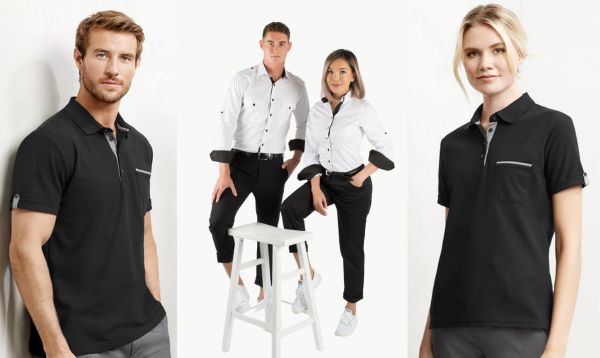Have you ever thought about how making uniforms for a large team is different to a smaller one? With a small team, you can be more flexible. It’s easier to offer more choices and adjust the uniforms to fit each person. There might be fewer roles to cover, like just a front desk or customer service, so you don’t need many different types of uniforms.
With a big team, it can be more complex. You might have different groups like warehouse workers, office staff, and customer-facing teams, all needing a uniforms. It’s not just about looking professional—it’s also about making sure everyone, in all roles, looks like part of the same company. Let’s look at some important things to think about when creating uniforms for a larger team.
1. Different Roles, Different Uniforms
When managing a large team, it’s common to have employees in a variety of roles, each requiring a different type of uniform to match their job needs. A good example of this is airlines. The pilots, flight attendants, and ground staff all wear different uniforms, but there look is cohesive and all branded the same.. This helps customers easily recognise who works where and creates a strong, unified brand image. Each group has distinct uniform needs based on their tasks and environment.
Even though the uniforms are different, it’s important to keep a consistent look with the same logo, colours, or style across all uniforms. This way, everyone looks like part of the same team.
2. Clear Guidelines, Less Flexibility
With more staff, it becomes harder to give one-on-one instructions about uniform expectations. To avoid confusion, stricter guidelines need to be in place. Setting up clear rules around what’s expected helps maintain consistency, so everyone knows exactly what’s allowed and what’s not, leaving less room for individual interpretations. In smaller teams, you might be able to allow more flexibility—like letting someone choose between a polo or a button-down shirt. The bigger the team, the clearer the rules need to be to avoid any confusion or mixed interpretations of what’s acceptable.
For example, in a hotel, front desk staff might be expected to wear formal attire, while housekeeping can have a more casual look. By setting strict dress codes, you ensure that every employee is dressed consistently, creating a unified and professional appearance across the entire team.
 3. Going Custom
3. Going Custom
When you have a variety of uniforms, like corporate suits, casual wear, and high-visibility outfits, you might need to go for custom uniforms. Custom pieces allow you to keep all uniforms branded and matching, regardless of the type. It’s about keeping that unified look across the board, no matter what role your employees are in.
For example, your corporate staff might wear formal suits with embroidered logos or even your front-of-house staff might wear casual or semi-formal attire, and your warehouse workers might wear high-visibility outfits for their safety with your company’s logo. With such a wide range of uniforms needed, it can be difficult to keep everyone looking on brand. That’s where custom uniforms can work really well. This ensures that no matter the job, everyone looks like they belong to the same team, with corporate colours matching across various garments.
4. Consistent Branding
No matter how many different uniforms you need, keeping your branding consistent is important. This means making sure all uniforms use the same brand colours, logos, and embroidery or transfers on the garments. Even if the uniforms look different for each job, branding helps tie everything together and makes your team unified.
Think of a hotel, the front desk staff might wear formal uniforms like blazers, while the housekeeping team wears more casual uniforms like polo shirts. But all the uniforms will have the same company logo in the same colour, making it clear that everyone works for the same team. This kind of branding keeps your team looking professional and helps customers easily recognize your staff, no matter their role.
 5. Sizing and Fits
5. Sizing and Fits
Not everyone has the same fits and size requirements and not everyone has the same taste and likes when it comes to style. It’s important for every staff member to feel comfortable and confident in their uniform. Companies need the option of a range of uniform sizes and fits to accommodate everyone. Some employees may prefer looser clothing, while others might want a more fitting look. Offering maternity uniforms is also essential so they can stay comfortable and maintain a professional appearance.
For example, in a large retail chain with many employees, you would need to have a variety of sizes available, from petite to plus-size. You might also want to offer different styles, such as slim-fit or relaxed-fit pants, to suit individual preferences. If just one employee wears a uniform that doesn’t fit well, it can affect their comfort and confidence and disrupt the uniform look of the team. By offering various sizes and fits, you ensure that every team member, no matter their body type, has a uniform that makes them feel good and presents a cohesive, professional appearance.
6. Easy Reordering System
Having a large team, uniforms are needed regularly, whether it’s for new employees, replacing worn-out ones, or having extras on hand. That’s why having an easy and quick system for reordering is essential. Without one, you might run into delays, leaving some team members without proper uniforms, which could affect their work or the company’s image.
Imagine a large retail store with dozens of staff, uniforms are constantly in use, and some may get damaged or misplaced. If you don’t have a quick way to reorder, it could mean some employees are left without the right clothing. A good solution is setting up a simple online ordering system where managers can place orders with just a few clicks. You can also keep a small supply of popular sizes in stock to make replacements even faster. This ensures your team always has the uniforms they need, and everything runs smoothly, even when new staff joins, or unexpected replacements are needed.

